by Elisa Zied | Jul 25, 2021 | books, fiction, graduate school, MFA, writer, writers, writing, young adult books
Full disclosure: Emma Kress is my dear friend. During our MFA studies, my Revisionary cohort at Vermont College of Fine Arts was lucky enough to adopt her (though we all respected the fact that we’d forever have to share her with the Tropebusters). Despite my obvious bias, this teacher and writer can only be described as a force, both as a human and a novelist. She has a lot to say and says it all with heart and hope and humor. Her powerful debut novel, Dangerous Play (Roaring Brook Press, August 3, 2021), more than proves that.
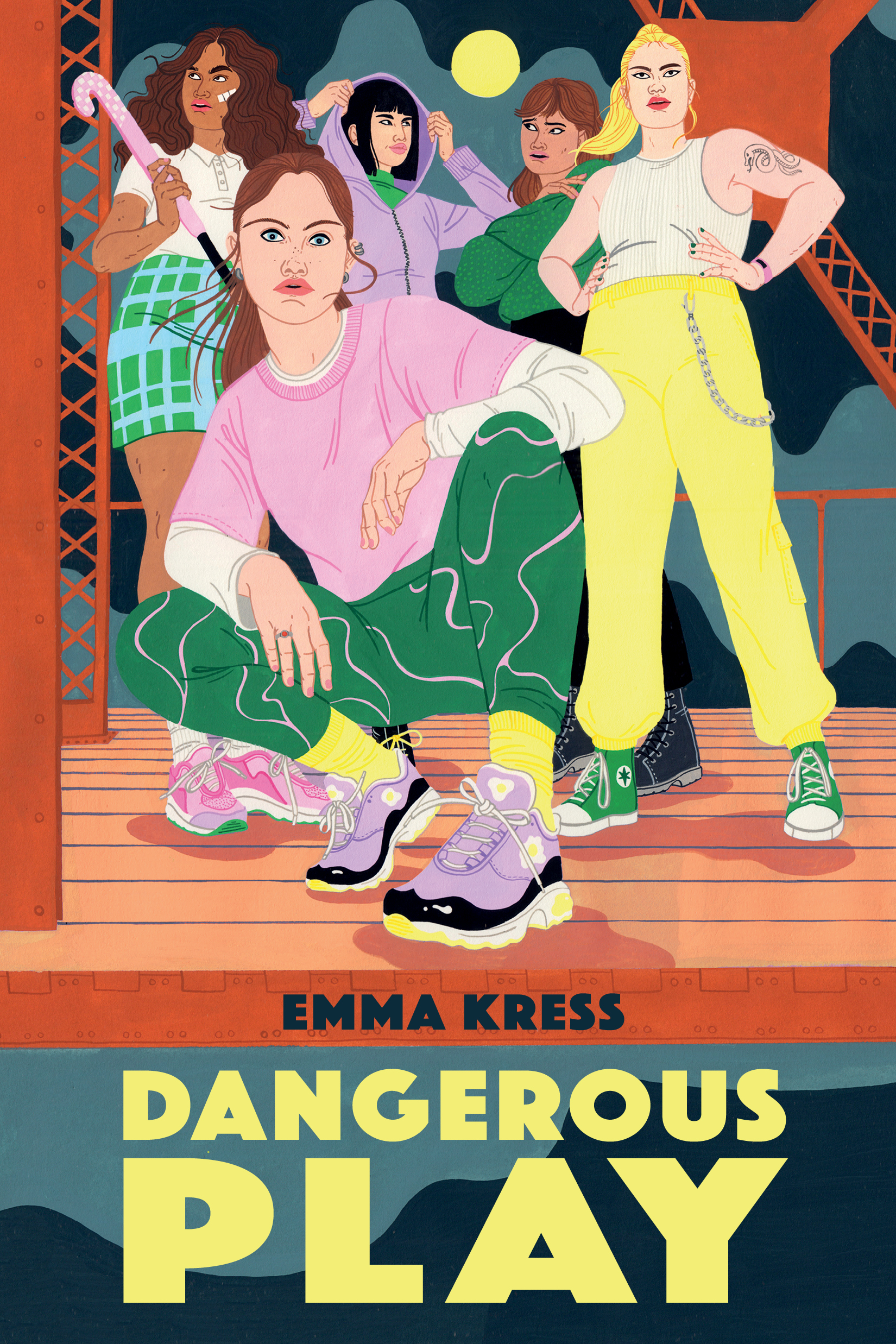 Described by Kirkus as “[A] contemporary feminist debut. . . . A timely and absorbing character study of a sexual assault survivor,” and by Corey Ann Haydu, author of Ever Cursed, as “Vibrant, daring, and deep, Dangerous Play is both a thrilling ride and a profound exploration of female friendship, rape culture, and the difficulty of doing the right thing in a world built on wrongs. An unflinching and empowering debut,” the novel is a timely, gripping and thought-provoking must-read for teens.
Described by Kirkus as “[A] contemporary feminist debut. . . . A timely and absorbing character study of a sexual assault survivor,” and by Corey Ann Haydu, author of Ever Cursed, as “Vibrant, daring, and deep, Dangerous Play is both a thrilling ride and a profound exploration of female friendship, rape culture, and the difficulty of doing the right thing in a world built on wrongs. An unflinching and empowering debut,” the novel is a timely, gripping and thought-provoking must-read for teens.
Here’s a brief description of the novel from Emma’s website:
Zoe Alamandar has one goal: win the State Field Hockey Championships and earn a scholarship that will get her the hell out of Central New York. She and her co-captain Ava Cervantes have assembled a fierce team of dedicated girls who will work hard and play by the rules.
But after Zoe is sexually assaulted at a party, she finds a new goal: make sure no girl feels unsafe again. Zoe and her teammates decide to stop playing by the rules and take justice into their own hands. Soon, their suburban town has a team of superheroes meting out punishments. But one night of vigilantism may cost Zoe her team, the championship, her scholarship, and her future.
I had the pleasure of doing an email Q and A with Emma about the novel and her writing life. Here are the highlights:
When did you know you were a writer, and at what point did you decide you’d write for children and young adults?
I’ve wanted to be a writer since I was ten but it took me until 2010 to take my writing seriously and commit to a daily practice. Writing for children and young adults was a natural choice as I was a teacher, surrounded by both children and children’s literature. At the start of my teaching career, I taught 5th grade and started a few middle-grade books. By the time I was writing seriously, I was teaching teens and reading a lot of YA fiction. But it was more than proximity, I think, that drew me to write for children and young adults. I think it was the same thing that drew me to teaching children and teens: our society underestimates kids, trivializes their concerns, and romanticizes their experience, all while exerting a lot of control over their existence. As a result, giving space on the page to teens and children is a radical act of resistance. And, most of my favorite stories center around change and power. I don’t think there’s any period of life that hits those more than childhood and adolescence.
What’s the greatest source of joy and fun for you when it comes to your writing life?
I love to learn and grow and writing offers a great path to both. I love figuring out the way the world or people work, though the eyes of my characters. I love the way a character can surprise me even though, technically, I’m the one doing the writing. I love the way at some point during the writing process I recognize some deep psychological struggle and get to say, “oh, that’s what you’re about.” Writing for me is like how running is for my husband—it keeps me steady, it keeps me sane. And, um, I don’t even need to sweat.

How has teaching fed into your creative life/process?
I think my love of teaching and the kids I’ve taught has been very helpful in terms of character voice and dialogue. I also feel very present in that time of life. I don’t have to rely on my memories as a teen when students are so ready to say, “you’ll never believe what just happened in the hall.” As a result, I think my stories feel authentic and of this moment. But I also think my commitment to honoring the voices and experiences of children and teens as a teacher is the same thing that drives me as a writer. As I said earlier, I think it is a radical act of resistance to listen to and honor children and teens.
How did getting your MFA at VCFA change your life (writing and otherwise)?
I could wax poetic about all that I love about VCFA for yeeears. VCFA gave me so many tools to improve my writing. As a result, I’m so much better at story structure, character development, side writing, and precision. But my time at VCFA was so much more for me than just a Home Depot for writing tools. VCFA emboldened me to experiment with new genres and audiences. VCFA fed my confidence and helped me pinpoint my strengths while shoring up my weaknesses. And I was actually shocked by the close-knit community. The alums I’d spoke to before I went all talked about it, but somehow, I didn’t think it would apply to me. Wow, I was wrong. It’s such a powerful network of talented and beautiful humans. I’d never been a part of an institution that was built on the twin pillars of compassion and creativity. As a teacher and former administrator, it was incredible to see that in action.
What are three tools you’ve used or created to help draft your novels?
My three biggest tools that I’m obsessed with right now:
- side writing
- working out problems with fat markers on big chart paper
- graph paper spreadsheets (not on the computer)
(For me, a big way to solve problems is often to step away from the manuscript and get off of the computer.)
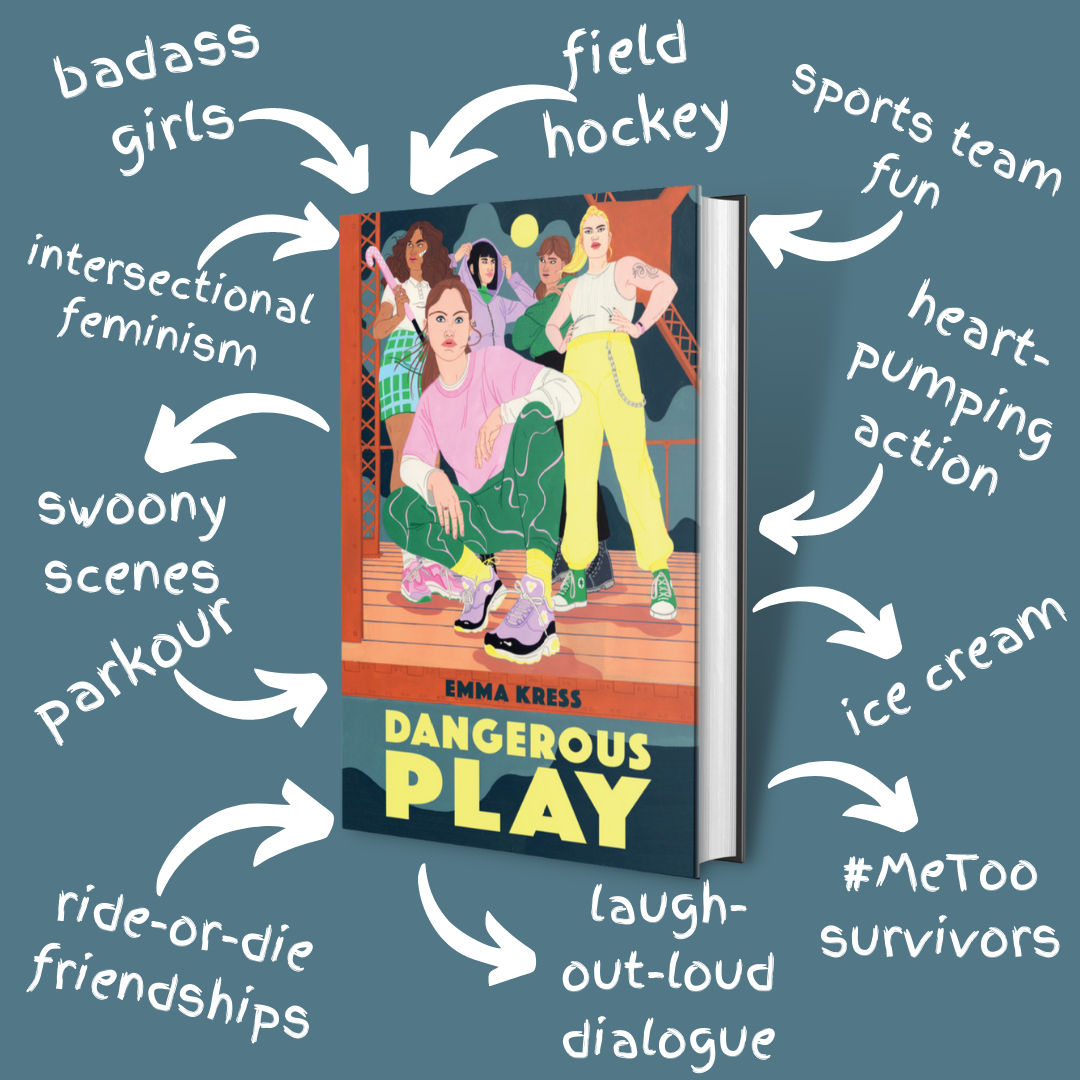 What was the spark that led to Dangerous Play, why was it important for you to write this particular story, and what did the process from spark to book look like?
What was the spark that led to Dangerous Play, why was it important for you to write this particular story, and what did the process from spark to book look like?
Dangerous Play is about the captain of a girls’ field hockey team. When she’s sexually assaulted, her ride-or-die team turn into vigilantes…but it might cost them everything.
This team of fierce, hyper-athletic, determined girls showed up when I was in the middle of writing something else. I told them to go away, but they didn’t listen. Even though they showed up sudden and loud, I had been thinking about some of book’s components for some time. For instance, I’d long noticed a gap in YA literature. While there were powerful books that followed a survivor’s journey, I didn’t see any books about rape culture overall. I’d also never seen a book about girls’ sports and the kinds of friendships that can happen on an intense, competitive girls’ team. I started writing Dangerous Play back in 2014. Thankfully, now there are books like Moxie, which address rape culture. And while there are more books featuring athletic girls (like 2021 debuts In the Same Boat, by Holly Green, and The Knockout, by Sajni Patel) there are few that feature full teams. As a result, I was thrilled when the girls of Dangerous Play showed up, filling a need I’d had for a long time. In many ways, this was the book I needed both when I was a teen, and as an adult.
Where do you like to write?
I used to like to write here, surrounded by books. And yet, thanks to the pandemic and everyone in my family in virtual school or working from home, I’m now squeezed in between my bed and the window on a folding table. But while it’s not as pretty, being able to shut my bedroom door is EVERYTHING.
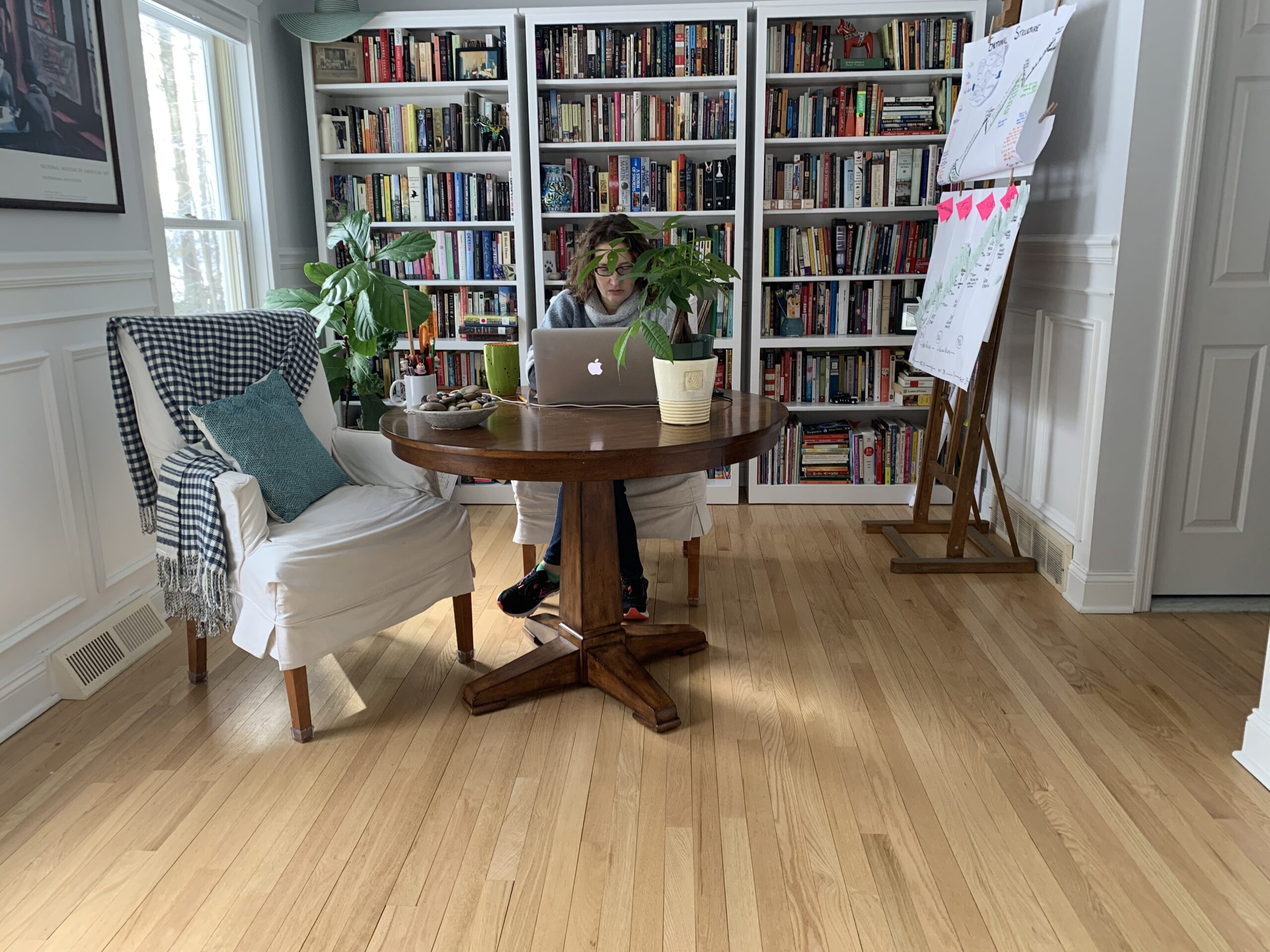

 What’s the best thing about transitioning from writer to debut author?
What’s the best thing about transitioning from writer to debut author?
EK: I’ve been thinking a lot about that old version of me—that 10-year-old girl—who wanted more than anything to be a published author. It’s a surreal and incredible thing to be able to give her this gift. How many people get to do that? It feels like a true privilege. And I think the gift feels all the bigger because of how long it took for me.
What’s the most challenging thing about transitioning from writer to debut author?
Every day I’m learning something new. Which in many ways is wonderful, because luckily I like to learn new things. But the learning curve is steep. It’s a bit daunting and tiring to be standing at the foot of yet another learning mountain on a near daily basis. Part of that is the debut year. But part of that is debuting in a pandemic. So even if I ask my mentors who are more experienced for advice or insight, none of them debuted in a pandemic so it makes things a bit more interesting for us pandemic debuters. Thankfully the kidlit community is the most inclusive and supportive of which I’ve ever been a part—so we’re weathering this together.
Please share any advice that’s helped you best (from others or yourself) in your kidlit career?
I think A LOT about my boat and I recommend every writer get themselves a boat. Inside my boat are the things I can control: honing my writing craft, how much I dedicate to my writing, how vulnerable I am on the page, getting the words on the page, teaching my kids to clap when I finish a draft. Literally everything else is outside my boat: book deals, reviews, lists, other people’s opinions, whether my kids actually clap, etc. It’s so helpful to train your focus inside your boat. In publishing, there are a lot of shiny somethings, lots of ego catnip, lots of opportunities to, as one writer friend likes to say, “compare and despair.” Retraining our focus to be inside our boat must be a habitual and intentional act. Let craft and our enjoyment of it be our unwavering center.
Hope Sparkers–what are they, and where can people get some?
I love that you asked! As you know, I’ve done a lot of research on hope and how helpful it can be for writers for children and young adults to incorporate hope as part of their writer’s toolkit. I made up the term “Hope Sparkler” to refer to all the things that I believe give us hope: friends/family/inspirational leaders in your community; religion/ philosophy/ belief system/ faith in ruling bodies; your own positive characteristics (creativity, humor, optimism, gratitude etc.); passion/talents (baking, gardening); place; and, of course, books. Books not only can contain hope sparklers but they can be them in their own right. If there’s anything we learned during this last year, it’s that we need as many hope sparklers as we can get. We need them to light our way during those dark days. And children need them most of all.
Where can writers and educators access your awesome Instagram videos for use in their practice or classroom?
Oh my gosh, these videos have been such a gift to me as well. Every single writer I’ve interviewed has offered such wisdom and inspiration. With the exception of one long-form video, all videos are about 15-minutes and packed with craft. At this point, there are thirty-six videos and you can find them all on my IGTV. I plan to offer these again during this year’s NaNoWriMo. I love any opportunity to blend my love of teaching and writing!
What’s on the horizon for Emma Kress?
I’m busy revising what I hope will be my second book—also a contemporary stand-alone YA. Like Dangerous Play, you can expect it to be feminist, funny, and fierce. On August 3rd, I’ll have a virtual launch with the great Nova Ren Suma along with several other upcoming launch events and writing workshops. I offer one general and one writing-focused newsletter every month (sign up here: https://www.emmakress.com/contact ). I’m also very active on all my social media. I look forward to connecting with all of you.
Some other mentions of Emma Kress and Dangerous Play to check out: A review on Publishers Weekly, a craft lesson on writing about sports on Kid Lit Craft.
Emma Kress is a long-time educator and 2014 finalist for NY State Teacher of the Year. She’s a graduate of Vassar College, Columbia University’s Teachers College, and the MFA program in Writing for Children and Young Adults at Vermont College of Fine Arts. She lives with her family in Saratoga Springs, NY. Dangerous Play is her debut novel. Learn more about Emma Kress and her amazing work on her website and on Instagram, Twitter, Facebook and TikTok.
by Elisa Zied | Jun 2, 2021 | books, writer, writers
If you tend toward perfectionism (like me), the following guest post, written by debut novelist and Instagram story star* Emma Kress, is a MUST READ. I saw the post in #SQUADGOALS, Kress’s awesome monthly newsletter, and thought it had so many nuggets to help us acknowledge and tame our inner (and outer) perfectionist. It’s too good not to share.
Stubborn Starfish
Let’s talk about perfectionism. Perfectionism isn’t the wink-wink negative trait we used to woo employers back when we first applied for jobs. Perfectionism isn’t an oh-so-cute strength masquerading as a flaw. Nope. It’s an honest-to-goodness evil within that we must hunt and kill on the regular.
I know, I know. I sound dramatic. But perfectionism IS dramatic. Certainly, the voice in my head gets awfully dramatic when it’s yelling at me that I’m not good enough. And, more important, the consequences of that voice can be deeply dramatic.
This recent editorial from the NY Times never names perfectionism but it does talk about America’s obsession with an unhealthy work ethic—one that’s maybe killing us. And I think maybe perfectionism is at the heart of that.
Perfectionism has two modes: work-to-the-bone or duck-and-cover.
Neither are good playmates with creativity.
Perfectionism isn’t something I’ve been able to chop off and leave behind like a good haircut. (I just got my first post-Covid haircut. The relief!) No. Perfectionism is a third limb that I hack away but it keeps growing back like a stubborn starfish. Stupid starfish.
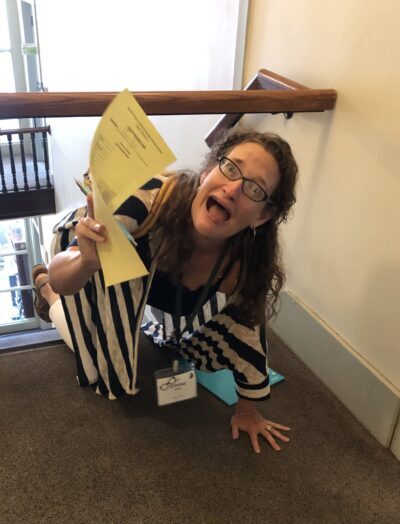
Emma making use of tip #5–Keep Going–as below. Moments before this photo was taken, Emma climbed many, many steps.
And lately, my perfectionism has been manifesting in duck-and-cover paralysis. What do I do when this happens?
1. Name it. “Oh, hey,” I say. “You again.” Now that I know perfectionism has a hold of the megaphone inside my head, well, it’s easier to dismiss. Because perfectionism is a liar.
2. Be self-compassionate. I take a daily routine—showering, toothbrushing, doing dishes—and the whole time I’m doing that routine I heap niceness on myself: Look at you! Washing dishes in a pandemic! You’re a downright superhero! (Revisit my last newsletter for saying nice things in the voice of your BFF.)
3. Step away. Rest. Read. Write silly things that don’t have a deadline or pressure attached. Garden. Make something. Get creative in a way that is all about being messy and imperfect—finger-paint with a toddler. If perfectionism tells you you’re not good enough so you better work yourself into sickness, well, show it you know how to rest. Get some work-life balance going.
4. Focus. The perfectionist paralysis for me often comes when I’m overwhelmed by All The Things I want this work to be and do. So focus. Allow yourself to be perfectionistic about one thing only. With writing that means I’ll focus on dialogue or setting or a minor character. Zero in.
5. Keep going. If perfectionism is all about telling you you’re not good enough so you might as well quit, well, keep going. Even if you’ve got no bounce in your step, your steps are still steps.
6. Virgo it up. I have no scientific basis for this but I’m pretty sure every Virgo is a perfectionist. While I can’t help that, I can use my love of schedules and routines to help fight perfectionism. Schedule the rest, physical exercise, playful writing, focus, and self-compassion.
7. Lean into the joy. What do you love about your work? Do that. Do that like your life depends upon it.
The people I love the most are the messiest. Perfectionism is a lie. Messy is authentic. So snatch that megaphone back from your inner perfectionist, and hand it to your inner BFF. You’ve got this.
You can preorder Emma Kress’s debut YA, Dangerous Play (Macmillan/Roaring Brook Press, August 3, 2021), here, and subscribe to her monthly newsletter about writing, books, and so much more by visiting her website.
*Check out Emma’s recent interview with the equally awesome A.S. King about her latest YA novel, Switch, writing, emotions, and life, right here.
by Elisa Zied | Oct 18, 2020 | books, writer, writers, writing
“This collection of poems and photos beautifully illustrates the complex emotions of living in New York during a global pandemic.” ~ Kelly Ripa, Entrepreneur, Host, Actress and Producer
Living in New York City during a global pandemic has been some combination of surreal, dispiriting, challenging and inspirational. While many of us have yet to fully process and make sense of what has transpired on our usually vibrant streets and in our parks over these last several months—especially in its early epicenter days—several artists have continued to create.
Nicole Freezer Rubens, a native New Yorker, owner of a boutique design firm, and mother of three, is one such artist. Through her dual passions—poetry and photography—she has beautifully and poignantly chronicled her personal experience during the pandemic and shown its impact on our beloved city in her gorgeous debut, “The Long Pause and The Short Breath” (Three Tomatoes Publishing, 2020).
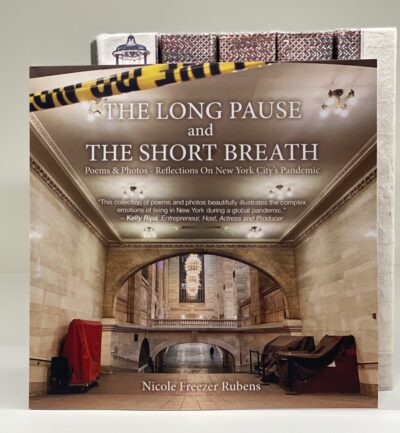 I had the pleasure of doing an Q & A with Nicole about her new book, one that gives readers a highly personal tour of the city during a moving and unforgettable time.
I had the pleasure of doing an Q & A with Nicole about her new book, one that gives readers a highly personal tour of the city during a moving and unforgettable time.
EZ: I’ve been enjoying your vibrant and gorgeous Instagram photos for years. What was it about the pandemic that made you take the plunge— not only to create a book of photos, but one that includes poetry too?
NFR: I have been writing poetry since I was 9 years old. Right after I read Shel Silverstein’s Where the Sidewalk Ends, I set out to create my first book of rhyming poems, bound in a denim blue loose leaf and including images and drawings. In college and after I studied poetry writing as well and throughout my life I have always written for myself. When the world shifted at the beginning of the global pandemic I was quite relieved that we were allowed to walk outside for exercise. Seeing our city empty out inspired me to write, often as I was walking in Central Park. With little else to do, I walked and explored a lot as a means to investigate and process what was happening. The poems began to accumulate after a few weeks. Not only did writing become therapeutic for me, but I began to feel a responsibility to myself to chronicle the events and repercussions of Covid-19 as a diaristic record for the future.
EZ: What was your process in taking and choosing photos specifically for the book, and how did you tackle the poetry (and do the photos pair with the poems or did you see them as separate if not related entities)?
NFR: I am generally a little obsessed with Instagram and love taking photos on my phone everywhere I go. Exploring new neighborhoods and photographing them is absolutely one of my favorite pastimes. When Covid prevented me from doing that, I began to take long walks to relatively local neighborhoods I had overlooked before. You ask an interesting question Elisa. The photos and poems were created as completely separate entities for me. Although they evolved simultaneously, I did not think to use them together until I realized that the poetry I had accumulated, was
becoming a body of work that could be a book. Once I finished writing I sat down to pair the poems with photos. This flowed naturally since they were captured to record the same subject matter of our city under lockdown.
EZ: So many writers and other artists have thrived during the pandemic, but many have also struggled (present company included). Did putting the book together help you cope and stay motivated during such tough times, or was it a struggle (or something in between)?
NFR: I have always had an easier time writing from the lows than from the highs. I have constantly used poetry writing as a coping mechanism. I realize as I write this, that that first binder of poems I wrote at nine, was written right after my parents got divorced. I am lucky because writing is a hobby, so I did not have the pressure to produce as so many artists do. I can say that on the days that I wrote a poem, I felt the satisfaction of productivity and that was personally rewarding and pushed me to continue to write. My interior design work was on hold for six months. My three grown children were home for three months, and cooking and cleaning occupied my days but did not satisfy me. I am very grateful that I was able to use some of my time on pause to create something long-lasting and that is important to me. It was not a struggle at all, it was more of a blessing for which I am grateful.
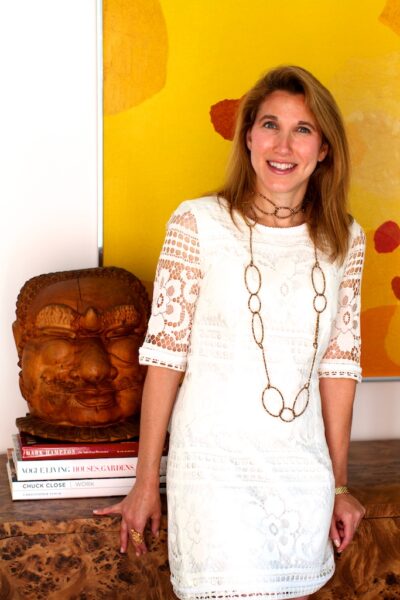 EZ: How would you sum up what you’ve experienced living in New York City during the pandemic, and what are some of the images or poems from the book that best encapsulate or capture the pandemic for you?
EZ: How would you sum up what you’ve experienced living in New York City during the pandemic, and what are some of the images or poems from the book that best encapsulate or capture the pandemic for you?
NFR: Overall, one of the most powerful aspects of being in NYC during the pandemic was bearing witness to the positive side of humanity. The Clap Because We Care round of cheering and applause that happened all over NYC at 7pm daily was always a bright spot in my day. Hearing, seeing and feeling the gratitude for and supporting the tireless healthcare workers and essential workers reminded me of the fundamental goodness in people and amplified my love for my city. Being able to scream for those two minutes, sandwiched between my family and neighborhood as we clapped, was a personal and helpful release. I also realized early on how fortunate I was in so many ways, including having bonus time together with my family. Although I felt frightened and deeply sad and frustrated, sharing that universal sense of loss with the world over made it easier to cope.
The cover image Off Limits of an empty Grand Central Station and You Are!! which shows a hand drawn heart-shaped message of strength taped to a lamppost truly define the times for me. Selecting a poem might be like picking a favorite child, but I can say that after I wrote March 30, 2020 about the field hospital being erected so unnaturally in Central Park, I felt I was on my way to having the writing soothe me.
EZ: What advice has helped you create in the face of a pandemic or grief or any kind or loss? (Or what advice would you offer to other artists?)
NFR: That is a very personal question, and each individual and creation is a unique situation which is what keeps artwork so interesting to me. I was always taught to write what you know, and the same applies to photography. I believe if one uses her voice, she will create from her truth and then it will certainly be meaningful and authentic.
The Long Pause and The Short Breath is available on Amazon or wherever books are sold. (If you don’t see it at your favorite independent bookstore or on their website, please request it.)
More about Nicole Freezer Rubens: She studied studio art, art history, creative writing and photography. Following a career in the art world, she launched NFR Consulting. Since childhood she’s written poetry and taken photos. Her favorite current pastime is exploring new neighborhoods and posting her treasured finds on Instagram. You can follow Nicole on Instagram at @nfrconsult.
by Elisa Zied | May 20, 2020 | books, fiction, writers
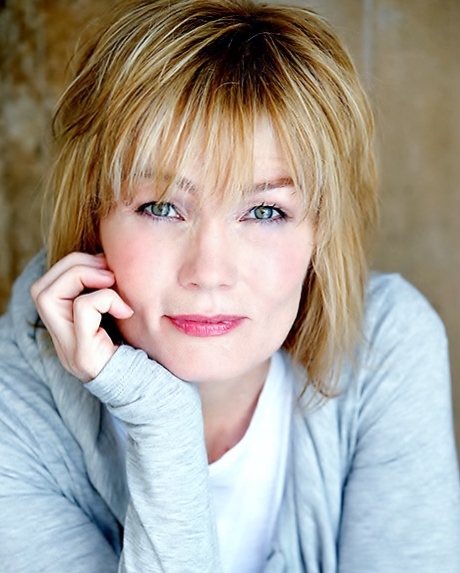 I am literally counting the minutes to read the sophomore novel of the amazing Kerry Kletter. Literally. Because I know East Coast Girls (MIRA, May 26, 2020) will be wonderful. Her writing is from the heart. Lyrical, poetic, painful, and beautiful. I expect nothing less from East Coast Girls.
I am literally counting the minutes to read the sophomore novel of the amazing Kerry Kletter. Literally. Because I know East Coast Girls (MIRA, May 26, 2020) will be wonderful. Her writing is from the heart. Lyrical, poetic, painful, and beautiful. I expect nothing less from East Coast Girls.
Here’s a description from Kletter’s website:
They share countless perfect memories—and one they wish they could forget.
Childhood friends Hannah, Maya, Blue and Renee share a bond that feels more like family. Growing up, they had difficult home lives, and the summers they spent vacationing together in Montauk were the happiest memories they ever made—campfires on the beach, salt-spray hair and the effervescent excitement of the bright future ahead. Then, the summer after graduation, one terrible night changed everything.
Twelve years have passed since that fateful incident, and during that time, their sisterhood has drifted apart, each woman haunted by her own lost innocence. But just as they reunite in Montauk for one last summer together, hoping to heal those wounds and find happiness once more, tragedy strikes again. This time it’ll test them like never before, forcing them to confront decisions they’ve each had to live with and old secrets that refuse to stay buried.
Told with lyrical prose and sharp insights into human nature, East Coast Girls unveils the dark truths that can threaten even the deepest friendships and the unconditional love that makes them stronger than ever.
I had the pleasure of doing an email Q & A with Kletter about the novel and her writing life. Here are the highlights:
EZ: You know I’m a big fan of your debut young adult novel, The First Time She Drowned. You had me at the first line (which I won’t spoil for others who haven’t yet read it). And I’m thrilled your sophomore novel, East Coast Girls, is out. What was the impetus to write it—and to write for an adult audience?
KK: First, thank you! You have been a wonderful champion of my first book and I can’t tell you how much I appreciate it.
You know when I published that book I felt such an outpouring of love and support from people from all aspects of my life and in particular the friends I grew up with on the east coast. Friends have always been a saving grace in my life and that support meant everything to me. I wanted to find a way to express my gratitude and so I decided to write a book that was, to me, a love letter to friendship. EAST COAST GIRLS is about a lot of other things as well—trauma, resiliency, compassion for our flawed humanity—but at its heart it’s about the beauty of lifelong friends.
As far as writing for an adult audience, my first book was technically considered a crossover novel—meaning that it might appeal to both young adults and adults so I didn’t really feel like I was leaping genres too much even though they are calling this my adult debut.
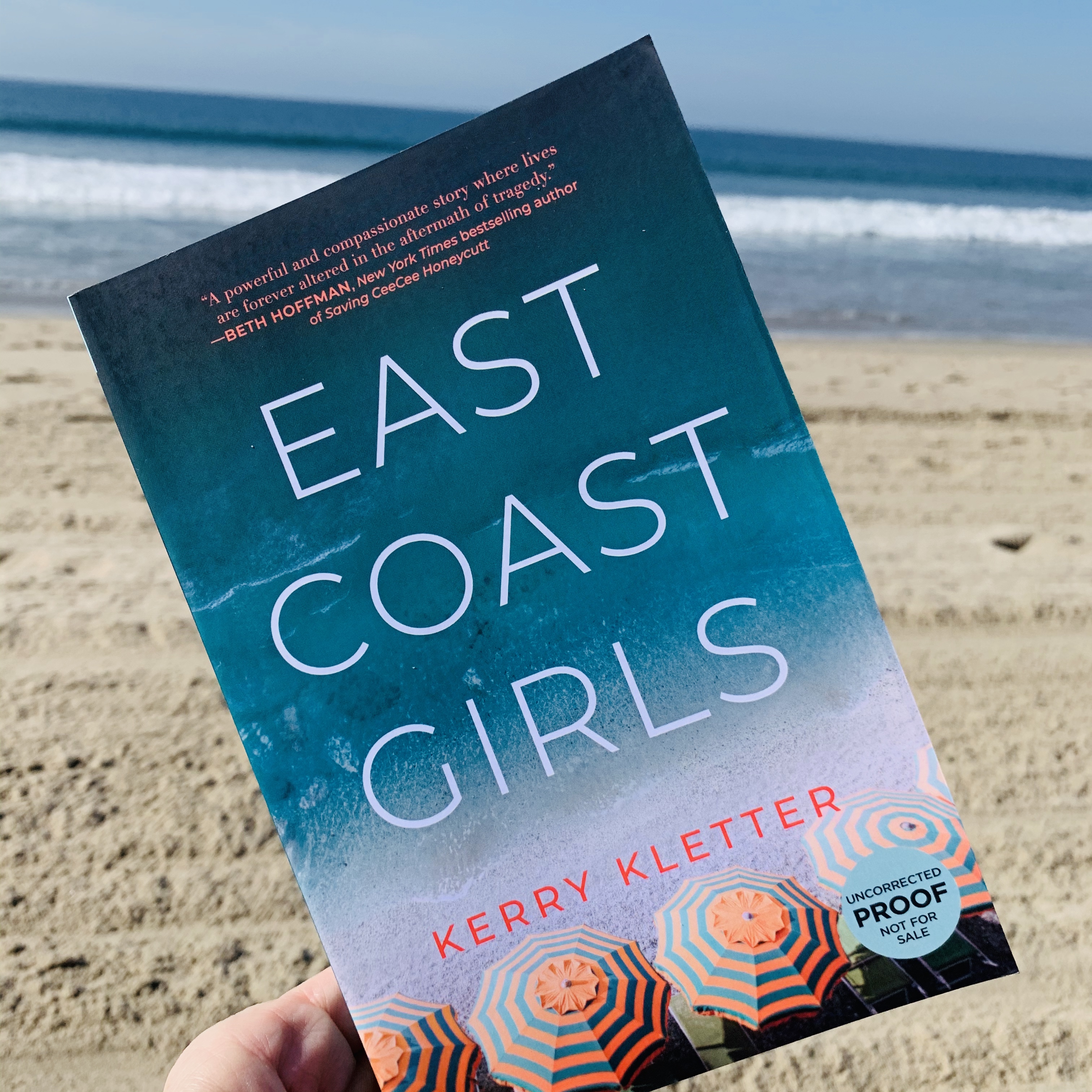 EZ: How was the process of writing East Coast Girls different from writing your first novel?
EZ: How was the process of writing East Coast Girls different from writing your first novel?
KK: I think second novels are harder in some way because now you have all the voices from the first book in your head—what sells, what readers like and don’t, what their expectations might be. It was tough to get past all of that and just write the story I wanted to tell.
EZ: What was the most challenging part of writing this novel in terms of craft and logistics?
KK: Having three narrators with three distinct personalities. Oy.
EZ: What was the best part of writing this novel?
KK: I think the thing I always like most about writing is that it allows me to grapple with questions I’m struggling with in my own life. In this book I was looking to answer two questions: “How do we acknowledge and accept the fragility of life and the fear of loss and still live and love fearlessly?” And then separately, “How do we cope with the fact that sometimes the people we love most cause us great pain and how do we know when to forgive and when to let go?” I feel like I learn by asking the question and letting the characters figure it out. Not that there are any easy answers, of course.
EZ: What do you need in terms of physical space and inspiration to sit down to write? And where and in what conditions do you do your best writing?
KK: A bed (my office), earplugs, laptop. I think I do my best writing after I’ve read really good writing. I’m always inspired by beautiful sentences.
EZ: What are some of your favorite recent reads?
KK: I loved Dear Edward by Ann Napolitano which I thought was beautiful and life-affirming and so carefully done. My Dark Vanessa by Kate Elizabeth Russell was a perfect book, just perfectly structured, absorbing, well written, honest. A lighter read I loved was Emily Henry’s Beach Read which is hilarious and swoony and has depth as well. It’s set to be a huge and well-loved book which thrills me because Emily happens to be an incredible person.
EZ: What novels are you most looking forward to diving into?
KK: I cannot wait for Stephanie Danler’s memoir Stray. I loved her first Sweet Bitter so much. I also really want A Star is Bored by Byron Lane, The Paris Hours by Alex George and Christina Clancy’s The Second Home. As for young adult novels, Jennifer Niven has a new one out in the fall called Breathless. I love everything she writes. And I’m looking forward to Laurie Elizabeth Flynn’s All Eyes on Her and Marisa Reichardt’s Aftershocks.
EZ: What most inspires your writing/story ideas?
KK: Honestly, mostly just life. Other books sometimes, but yeah mostly life.
EZ: How has the current pandemic affected your creative/writing life?
KK: I’m being surprisingly productive! Writing is such a focused activity—I use it to help regulate myself and forget the big problems of the world for a while. It gives me a sense of purpose and meaning as well.
EZ: When you’re not writing, how do you like to spend your time—pre-covid-19 and during the pandemic?
KK: Pre-covid—spending time with friends, running, surfing, skiing, reading, binging netflx. During covid—running (mask on!) writing, binging Netflix, and much-needed organizing of my apartment. And in both cases too much Twitter.
EZ: How can friends, family, other authors and fans support you and your work during the pandemic? Where can they find you online?
KK: Obviously there are much bigger problems in the world, but it is an unfortunate time to be releasing a book. It’s harder for new books to get traction when all the bookstores are closed, book tours and events cancelled, and there are no booksellers handselling your book or even opportunities for people to impulse buy off the shelf. I never want anyone to feel they have to do anything to support me, but if they wanted to I’d be thrilled of course if anyone bought the book or asked their local library to buy it if they haven’t yet. Beyond that, social media posts and recommendations to friends are incredibly helpful in spreading the word—my friends, fellow authors and readers have always been so amazing with that and I’m so grateful. And, of course, Amazon reviews are always helpful. Unless you hated the book in which case, not so much 😊.
I can be found on Instagram and Twitter as @Kkletter, and on Facebook under Kerry Kletter. My website is Kerrykletter.com.
EZ: What’s next for Kerry Kletter?
KK: Finishing the third book, trying not to go stir crazy, and awaiting YOUR first novel.
EZ: Where would you like people to buy your books?
KK: I want people to shop where they want to but, if they are able, I encourage them to buy from their local independent bookstore or from Bookshop.org which supports indies. Those stores really need us right now and I’m very worried about publishing if we lose them.
Read an excerpt of East Coast girls here.
by Elisa Zied | Sep 15, 2019 | books, fiction, writer, writers, writing, young adult books
Laura Taylor Namey is a woman on a mission. This dog loving, piano playing, former teacher is a mother of two and full time writer. She aspires to live in London someday, but right now is truly living the dream (and working her a** off) as the debut author of the brand new young adult novel, The Library of Lost Things (Inkyard Press, October 2019). Here’s a description of the novel from Goodreads:
From the moment she first learned to read, literary genius Darcy Wells has spent most of her time living in the worlds of her books. There, she can avoid the crushing reality of her mother’s hoarding and pretend her life is simply ordinary. But when a new property manager becomes more active in the upkeep of their apartment complex, the only home Darcy has ever known outside of her books suddenly hangs in the balance.
While Darcy is struggling to survive beneath the weight of her mother’s compulsive shopping, Asher Fleet, a former teen pilot with an unexpectedly shattered future, walks into the bookstore where she works…and straight into her heart. For the first time in her life, Darcy can’t seem to find the right words. Fairy tales are one thing, but real love makes her want to hide inside her carefully constructed ink-and-paper bomb shelter.
Still, after spending her whole life keeping people out, something about Asher makes Darcy want to open up. But securing her own happily-ever-after will mean she’ll need to stop hiding and start living her own truth—even if it’s messy.
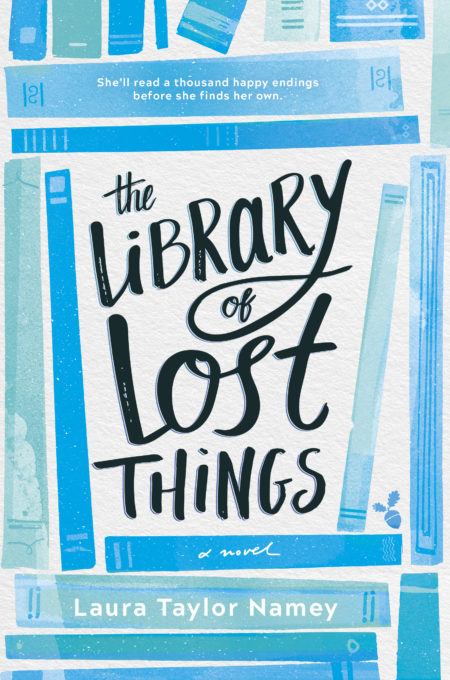 I had the pleasure of doing an email interview with my lovely friend whom I had the pleasure of meeting several years ago at a Society for Children’s Book Authors and Illustrators annual conference. Read on to learn about her writing journey and why she loves #pitchwars and her critique partners (not necessarily in that order).
I had the pleasure of doing an email interview with my lovely friend whom I had the pleasure of meeting several years ago at a Society for Children’s Book Authors and Illustrators annual conference. Read on to learn about her writing journey and why she loves #pitchwars and her critique partners (not necessarily in that order).
EZ: At what point in your life did you know you wanted to write for children and young adults? And when did you know you were a writer?
LTN: I have always felt like a natural writer, even if I didn’t have the logistics figured out until a few years ago. I am a former teacher, and I found myself using a lot of literature in my classroom lessons. I began to long for the chance to write my own stories. About five years ago, I started writing a young adult novel (this one will forever live in a drawer). I’d had no formal training, but I used that work to find out what I really did need to work on more. I got help, read a ton, and decided that I wanted to focus on the young adult age group. I love the emphasis on coming-of-age themes, high-concept storytelling, and exploring complex and relevant topics.
EZ: What has been the best part of transitioning from a pre-published to a published author?
LTN: I have such admiration and respect for career authors, and creators who consistently come up with beautiful and compelling content. Being able to take my small place beside them, with the word Published next to my name, is an incredible experience.
EZ: How do you fit writing into the rest of your life (and fit the rest of your life into your writing)?
LTN: I am blessed to have a supportive family, and the opportunity to write full time right now. I work best in the morning, so having a new teen driver in my home has helped to free up some of my time to build up my word count before lunch time. I take breaks to take care of my home and family, and to squeeze in a workout. Admittedly, I don’t watch a lot of TV. I am usually writing, or reading during down time.
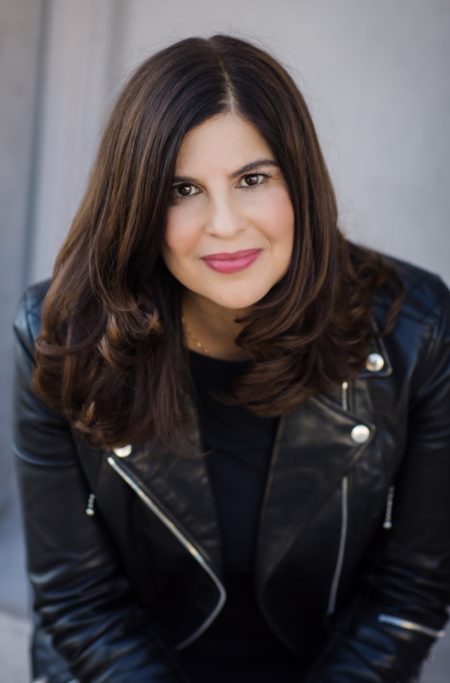 EZ: What are your favorite kinds of books to read, and how do they inspire your writing?
EZ: What are your favorite kinds of books to read, and how do they inspire your writing?
LTN: I love books that stick with me long after I’ve finished them. I enjoy a wide variety of authors, age groups, and genres. Make me care, feel, and want to chat about your book all day and that’s my idea of a winner. I believe all writers need to actively read other writers. I am most inspired by other authors in the areas of scope and opportunity. There are so many ways to attack and deconstruct even the same topic in drastically different ways with differing points of view. Reading more only confirms my belief that so many possibilities lay in front of our pens.
EZ: Can you describe your experience with #pitchwars on Twitter?
LTN: I was a 2017 #pitchwars unofficial mentee. Besides working with a fantastic mentor who became the first person to work on THE LIBRARY OF LOST THINGS, #pitchwars brought me into a supportive community of writers. This is the real prize in any online contest. Put your work out there. Meet fellow writers. Team up and share and hone your craft together, and know that you are not alone in your struggles and hopes.
EZ: You are a big fan of your critique partners. How did you meet them, and what makes your partnership work? What advice do you have for other writers who want to work with critique partners or groups?
LTN: I have two fantastic critique partners that work with me almost every day. We met because we were all 2017 #pitchwars unofficial mentees. We began chatting privately on Twitter DM, and became lifelong friends through sharing our work and supporting one another. What sets our group apart is that we don’t wait until we finish a novel to edit or weigh in. We are always working together on our three individual manuscripts. We plan together from idea-up, talk through issues, name towns or characters, and share snippets of our writing as we go. When I get stuck, I can ask a question directly from the point of concern. My partners already have such a deep knowledge of my manuscript, plot and theme, and character arcs, that they can weigh in quickly. And I do the same for their work.
For those who would like to join or form a group like this, hang out on private writer’s boards or the community groups associated with social media programs, such as #pitchwars. Put yourself out there. It might take some time, but you will find your people. It’s okay if you try out a CP and that person isn’t quite right for you. Keep sharing and investing in others.
How will you know if you are collaborating with the best people for you? Your perfect CPs will be similar enough to you and your work that they share a taste level and basic skill level. But they should be different enough that they can expand your scope and contribute to your growth. A good CP walks beside you, while also possessing the tools to push you. My CPs and I are the best of friends, but when it’s time to work, we give tough feedback with love.
EZ: What are you currently working on? And where do you see yourself in five years?
LTN: Right now I am almost finished with the draft of a secret junior novel. I’m hanging out in the young adult contemporary world for a while, and hope to have a few books side-by-side on shelves in five years.
To learn more about Laura Taylor Namey and The Library of Lost Things, visit her website. You can also find her on Twitter and on Instagram. Stay tuned for Namey’s sophomore novel, A Cuban Girl’s Guide to Sweaters and Stars (Simon & Schuster, Fall ’20) and future titles as well!
by Elisa Zied | Apr 27, 2019 | books, fiction, writers, young adult books
When I heard about J.B. Howard’s debut novel, When I Was Summer (Viking Books for Young Readers, April 30, 2019) and saw the absolutely gorgeous book cover, I began counting the days until it would be in my hands. Intrigued by the promise of music and mystery (maybe some mating too?!), I pre-ordered the novel and anxiously await its arrival. If it turns out to be anything at all like its author–because what work of fiction doesn’t include at least part of the soul from which it comes–I can’t imagine it’ll be anything less than awesome.
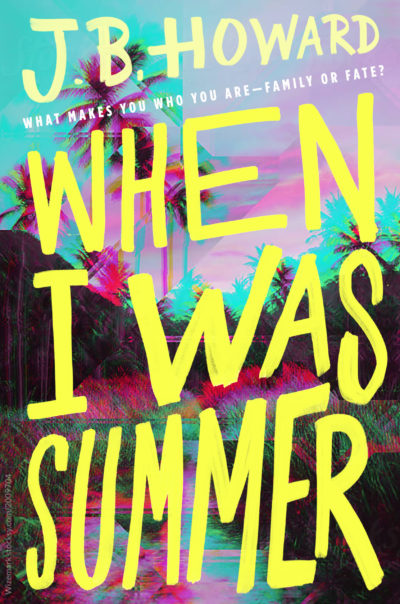 Here’s a description of When I Was Summer from the publisher:
Here’s a description of When I Was Summer from the publisher:
A relatable novel about unrequited love, rock ‘n’ roll, and what you find when you go searching for yourself.
Sixteen-year-old Nora Wakelin has always felt like an outsider in her own family. Her parents and older sister love her, but they don’t understand anything about her: not her passion for music, not her all-encompassing crush on her bandmate Daniel (who is very much unavailable), not her recklessness and impulsiveness. Nora has always imagined that her biological mother might somehow provide the answer as to why she feels like such an outsider.
(more…)
 Described by Kirkus as “[A] contemporary feminist debut. . . . A timely and absorbing character study of a sexual assault survivor,” and by Corey Ann Haydu, author of Ever Cursed, as “Vibrant, daring, and deep, Dangerous Play is both a thrilling ride and a profound exploration of female friendship, rape culture, and the difficulty of doing the right thing in a world built on wrongs. An unflinching and empowering debut,” the novel is a timely, gripping and thought-provoking must-read for teens.
Described by Kirkus as “[A] contemporary feminist debut. . . . A timely and absorbing character study of a sexual assault survivor,” and by Corey Ann Haydu, author of Ever Cursed, as “Vibrant, daring, and deep, Dangerous Play is both a thrilling ride and a profound exploration of female friendship, rape culture, and the difficulty of doing the right thing in a world built on wrongs. An unflinching and empowering debut,” the novel is a timely, gripping and thought-provoking must-read for teens.
 What was the spark that led to Dangerous Play, why was it important for you to write this particular story, and what did the process from spark to book look like?
What was the spark that led to Dangerous Play, why was it important for you to write this particular story, and what did the process from spark to book look like?

 What’s the best thing about transitioning from writer to debut author?
What’s the best thing about transitioning from writer to debut author?
 I had the pleasure of doing an Q & A with Nicole about her new book, one that gives readers a highly personal tour of the city during a moving and unforgettable time.
I had the pleasure of doing an Q & A with Nicole about her new book, one that gives readers a highly personal tour of the city during a moving and unforgettable time. EZ: How would you sum up what you’ve experienced living in New York City during the pandemic, and what are some of the images or poems from the book that best encapsulate or capture the pandemic for you?
EZ: How would you sum up what you’ve experienced living in New York City during the pandemic, and what are some of the images or poems from the book that best encapsulate or capture the pandemic for you? I am literally counting the minutes to read the sophomore novel of the amazing Kerry Kletter. Literally. Because I know East Coast Girls (MIRA, May 26, 2020) will be wonderful. Her writing is from the heart. Lyrical, poetic, painful, and beautiful. I expect nothing less from East Coast Girls.
I am literally counting the minutes to read the sophomore novel of the amazing Kerry Kletter. Literally. Because I know East Coast Girls (MIRA, May 26, 2020) will be wonderful. Her writing is from the heart. Lyrical, poetic, painful, and beautiful. I expect nothing less from East Coast Girls.  EZ: How was the process of writing East Coast Girls different from writing your first novel?
EZ: How was the process of writing East Coast Girls different from writing your first novel? I had the pleasure of doing an email interview with my lovely friend whom I had the pleasure of meeting several years ago at a
I had the pleasure of doing an email interview with my lovely friend whom I had the pleasure of meeting several years ago at a  EZ: What are your favorite kinds of books to read, and how do they inspire your writing?
EZ: What are your favorite kinds of books to read, and how do they inspire your writing? Here’s a description of When I Was Summer from
Here’s a description of When I Was Summer from
Recent Comments